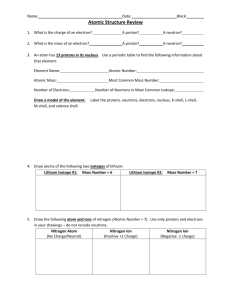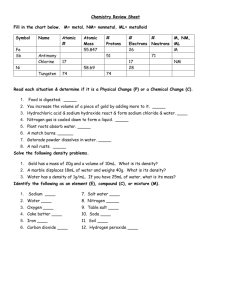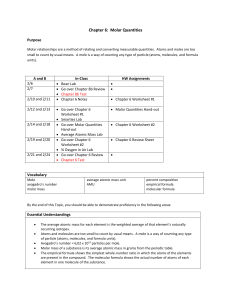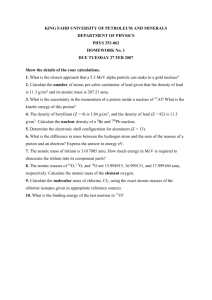File - Mr Liang`s Science
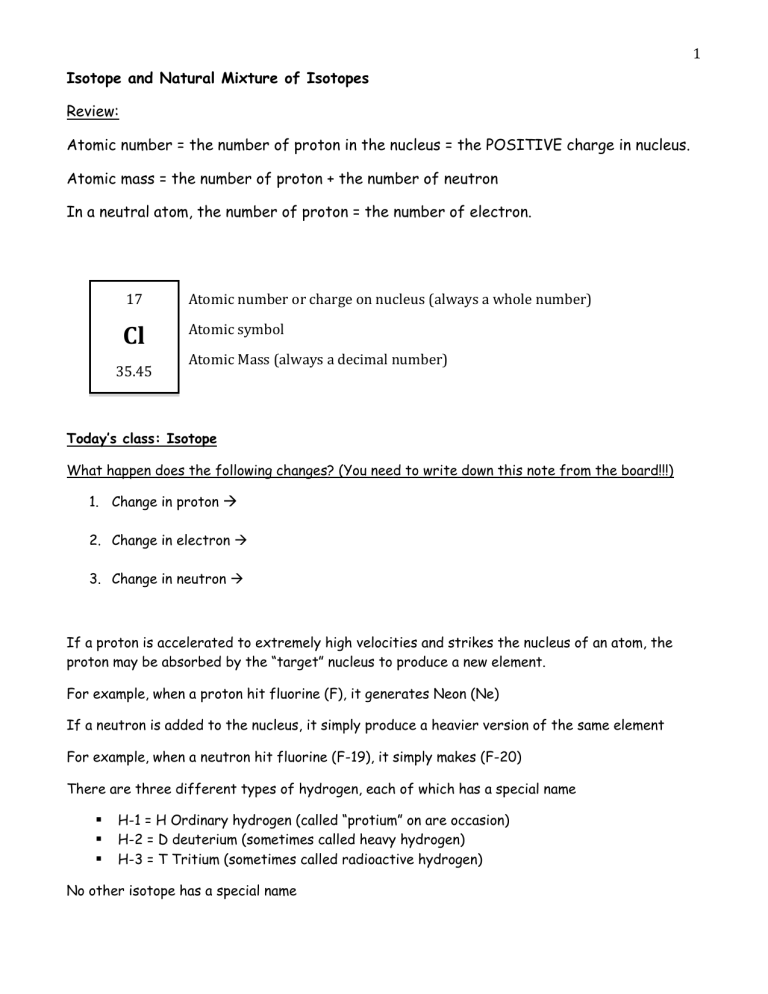
Isotope and Natural Mixture of Isotopes
Review:
Atomic number = the number of proton in the nucleus = the POSITIVE charge in nucleus.
Atomic mass = the number of proton + the number of neutron
In a neutral atom, the number of proton = the number of electron.
17
Cl
35.45
Atomic number or charge on nucleus (always a whole number)
Atomic symbol
Atomic Mass (always a decimal number)
Today’s class: Isotope
What happen does the following changes? (You need to write down this note from the board!!!)
1.
Change in proton
2.
Change in electron
3.
Change in neutron
If a proton is accelerated to extremely high velocities and strikes the nucleus of an atom, the proton may be absorbed by the “target” nucleus to produce a new element.
For example, when a proton hit fluorine (F), it generates Neon (Ne)
If a neutron is added to the nucleus, it simply produce a heavier version of the same element
For example, when a neutron hit fluorine (F-19), it simply makes (F-20)
There are three different types of hydrogen, each of which has a special name
H-1 = H Ordinary hydrogen (called “protium” on are occasion)
H-2 = D deuterium (sometimes called heavy hydrogen)
H-3 = T Tritium (sometimes called radioactive hydrogen)
No other isotope has a special name
1
Exercise question
1. Fill up the blank in the table. Show the atomic number and atomic mass in the “symbol” column.
In this question, you only use the atomic number to find the atom in the periodic table, NOT atomic mass
2
Symbol
Zn
Cd 2+
X 2 =
X 3+ =
X 3 =
Atomic mass Atomic number
84
127
112
103
36
53
27
33
Number of protons
35
38
Number of neutrons
45
32
36
50
75
42
Number of electrons
36
35
54
27
36
54
42
2. “Heavy water” has the formula D
2
O. D is an isotope of hydrogen. A chemist has two samples: one contains pure “ordinary” water and the other contains pure “heavy” water. Measure the mass and volume of each sample gives the following results.
Volume of ordinary water = 25.00 mL
Mass of ordinary water = 25.00 g
Volume of heavy water = 25.00 mL
Mass of heavy water = 27.65 g
Since isotopes only differ in their masses and have similar atomic diameters, the sample of heavy and ordinary water contain equal number of molecules. a) How many times heavier than an ordinary water molecule is a heavy water molecule? b) If ordinary water has a molar mass of 18.0 g, what is the molar mass of heavy water? c) The formula of heavy water is D
2
O. Since “O” has a molar mass of 16.0 g, what is the molar mass of the isotope “D”? d) How many electrons, protons, and neutron does a neutral atom of D possess? How many electrons, protons, and neutrons, does a neutral atom of H posses? Suggest why D is called heavy hydrogen
Natural mixture of isotopes
The molar mass of chlorine is 35.5g. Since there can’t be 0.5 of a proton or neutron, then “35.5g” must represent an average value for a mixture of isotope. (Similarily, “the typical Canadian family has 2.5 children” is a statement referring to an average)
Example: experiment show the chlorine is a mixture which is 75.5% Cl-35 and 24.23% Cl-37. If the precise molar mass of Cl-35 is 34.968853 and Cl-37 is 36.965903, what is the average molar mass of the chlorine atoms n such a mixture?
Solution:
Mass of Cl-35 in mixture = 0.755 mol x 34.968852 g/mol = 26.4959 g
Mass of Cl-37 in mixture = 0.2423 mol x 36.965903 g/mol = 8.9569 g
And total mass = 26.4959 + 8.9560 = 35.453 g, the mass agree with the value of 35.453 g found experimentally for naturally occurring chlorine because exact masses were used for for Cl-35 and Cl-37
If the question does not give you the exact molar mass, instead, give you the following
35 Cl = 75.77% and 37 Cl = 24.23%
Then use the atomic mass at the superscript
Average mass = 0.7577 x 35 + 0.2423 x 37 = 35.485
The average is less exact, but still satisfactory for most purpose.
Exercise
1.
the following mixture of isotopes are found in nature. Calculate the expected molar mass of a sample of each mixture. a.
10 B= 18.8%, 11 B= 81.2% b.
107 Ag= 51.8%, 109 Ag= 48.2% c.
70 Ge= 20.5%, 72 Ge= 27.4%, 73 Ge= 7.8%, 74 Ge= 36.5%, 76 Ge= 7.8% d.
64 Zn= 48.9%, 66 Zn = 27.8%, 67 Zn = 4.1%, 68 Zn = 18.6%, 70 Zn = 0.6%
3
4
2.
Natural sample of carbon contain 98.90 % of C-12 (mass = 12.000000) and 1.10% C13 (mass
= 13.003355). What is the molar mass of the mixture of carbon isotopes, express to 3 decimal places?
3.
Naturally occurring silicon consists of 92.23% C-12 (mass= 27.976927 g), 4.67% Si-29
(mass= 28.976496 g) and 3.10% Si-30 (mass= 29.973770 g). What is the expected average molar mass of a sample of natural silicon, expressed to 4 decimal paces?

